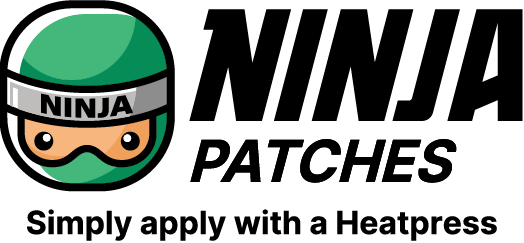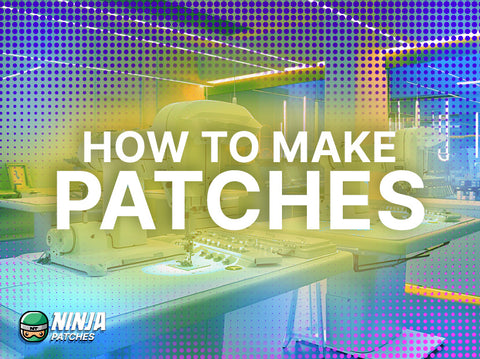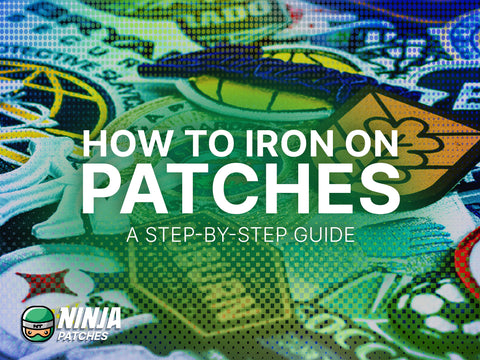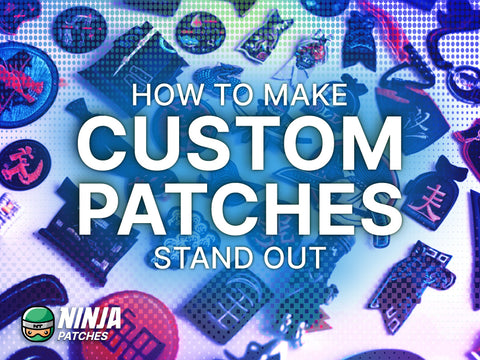Making your apparel stand out is simple with patches. Customizing apparel or accessories with patches is a popular choice for a wide range of individuals. From sports teams and schools to clubs, events, and organizations, patches can be customized to suit your every need.
But how do you go about making patches? With so many options to choose from online, the choices can be a little overwhelming. In this article, we’ll be talking you through the step-by-step of how to make patches for your event, school, team, or simply for daily personal use. Read on to find out more!
Table Of Contents
- Patch Design Tips & Tricks
- Choosing The Right Material
- Choosing The Right Placement
- Placing Your Order
Patch Design Tips & Tricks
The first place to start when it comes to making patches is the design of the patch itself. Ensuring you have the right image can make your patch stand out when you apply it to your apparel or accessories. Follow our top tips for designing patches below:
Tip #1 Keep Your Design Simple
Simplicity is the most important design for patches. Keeping it simple will mean your patch remains legible and recognizable from a distance. With patches being so small, having very intricate or small details on your patch design may not translate well.
Tip #2 Include Bold Colors
Being bold and vibrant with the colors and lines on your design can help to make the pop. Make sure that the colors you choose for your design reflect your brand or messaging to make them easily recognizable. Some colors can carry symbolism for example, green often reflects environmental themes. Your color combinations should also contrast to make them visible from a distance and ensure that their details stand out. The most important thing is that all of your colors complement each other.
Tip #3 Highlight Specific Features
Try to highlight the most important features of the patch, such as the logo, emblem, or critical text. This will help to direct people’s attention to these important features and make it obvious what they stand for.
Tip #4 Consider The Patch Type
The patch type you choose will have an influence on your design. For example, leather patches are laser cut which means your design will be in the color of the leather. Whereas print and embroidery patches combine techniques to offer more intricate detailing.
Tip #5 Letters Should Be No Smaller Than ⅛”
Lettering that is too small compromises legibility, which can reduce the impact of your patches. If you are using both upper case and lower case letters, make sure that the lower case lettering is no smaller than ⅛”.
Choosing The Right Patch Materials
When learning how to make patches, choosing the right material is important. This can impact the design that you place on the patch, the type of placement, and how you apply them to your apparel or accessories. It can also impact the print technique for your design to be transferred onto the patch itself. Read on for our breakdown of the different types of patch materials available here at Ninja Patches.
Embroidered Patches
Embroidered patches are created using a fabric backing and thread to produce a design or artwork.
Good For: Apparel such as jackets, hats, and jeans; accessories such as bags, military units, and uniforms; collectibles, and sports events.
Application Method: Apply using a heat press at 315 degrees for 15 seconds, and cool peel. Or choose a peel & stick option for one-time use. View our heat press instructions for embroidered patches.
Full Color Printed
Full-color printed patches are textile patches where designs are printed directly onto the fabric. These patches use sublimation for vibrancy and color depth.
Good For: Clothing, bags, merchandise, souvenirs, promotional items.
Application Method: Apply using a heat press at 315 degrees for 15 seconds, and cool peel. Or choose a peel & stick option for one-time use. View our heat press instructions for sublimated patches.
Print & Stitch Patches
Print & stitch patches, or print & embroidered patches are a combination of full-color printing and embroidery to combine the two techniques. They use sublimation to provide intricate and bold designs.
Good For: Custom apparel, decorative home items, craft projects, branding and promotional items.
Application Method: Apply using a heat press at 315 degrees for 15 seconds, and cool peel. Or choose a peel & stick option for one-time use. View our heat press instructions for print & stitch patches.
Silicone Patches
Silicone patches, also known as PVC patches, are waterproof and dimensional. Made from silicone rubber, they are well known for their durability and versatility while being resistant to extreme temperatures and weather conditions.
Good For: Apparel, promotional items, industrial applications.
Application Method: Apply using a heat press at 315 degrees for 15 seconds, and cool peel. View our heat press instructions for silicone patches.
Rhinestone Patches
These decorative embellishments utilize small, precision-cut stones made from glass. These create sparkling designs that offer a touch of glamour and luxury.
Good For: Fashion and apparel, performance costumes, accessories, event and promotional items, and DIY projects.
Application Method: Apply using a heat press at 315 degrees for 15 seconds, and cool peel. Or choose a peel & stick option for one-time use.
Leather Patches
Leather patches use laser-etching to give a distinctive look to your patches. The shades of leather can vary and offer a rustic feel for your apparel or accessories.
Good For: Jackets, jeans, handbags, wallets, belts, shoes, hats, backpacks, souvenirs.
Application Method: Only heat press. Apply using a heat press at 315 degrees for 15 seconds, and cool peel. View our heat press instructions for leather patches.
Faux Leather Patches
Giving the look and feel of real leather but without the price tag. These are laser engraved to provide a rustic look.
Good For: High-end fashion and apparel, branding, accessories and gifts.
Application Method: Only heat press. Apply using a heat press at 315 degrees for 15 seconds, and cool peel. View our heat press instructions for faux leather patches.
Woven Patches
The best of both worlds of thread and flexibility. Our interlaced woven patches allow you to create intricate designs and patterns without using fabric. They offer fine detail and clarity while giving a traditional look and feel.
Good For: Sports teams and fans, clothing, uniform, accessories and organizations.
Application Method: Only heat press. Apply using a heat press at 315 degrees for 15 seconds, and cool peel. View our heat press instructions for woven patches.
Chenille Patches
A timeless option for jackets, sweaters, bags and more. The classic varsity letters with a modern design. Bold colors, intricate details and lettering. With plush texture, soft touch and clean edges.
Good For: Letterman jackets, uniforms, school apparel, sports teams and corporate branding.
Application Method: Only heat press. Apply using a heat press at 315 degrees for 15 seconds, and cool peel. View our heat press instructions for chenille patches.
3D Embroidered Patches
Combining direct embroidery with bold designs. With the ability of custom die cut shapes and 3D raise effect on any section, these patches add a pop to your patch.
Good For: All suitable for fabrics, type of clothing and accessories.
Application Method: Apply using a heat press at 315 degrees for 15 seconds, and cool peel. Or choose a peel & stick option for one-time use. View our heat press instructions for 3D embroidered patches.
Choosing The Right Placement
Choosing the right placement for your patch can help to improve its visibility. There are a number of areas to consider before you apply a patch to a garment or accessory, including the purpose of the patch, the item’s design and the practical aspects. We’re breaking down some of the key considerations to help you choose the right placement for your custom patches.
1. Purpose & Visibility
Thinking about the purpose of your patch before you decide what type of patch and where to place it. Is it for identification, decoration, branding, or commemorating an event? The purpose of your patch will impact the placement as this will determine visibility or subtlety. For example, patches used for branding or events are usually placed on the chest or sleeve of a shirt.
2. Garment Type
The type and material of the clothing or accessory that you are attaching it to will affect the placement. For example, on a jacket, common places include the chest, back, sleeves or collar. On a backpack, consider areas that face outward.
3. Shape & Size Of The Patch
The patch’s dimensions can determine where it fits the best. For example, large patches are more suited for the back of jackets or on teh front of t-shirts, whereas smaller patches may be better on sleeves, pockets and hats.
4. Fabric & Structure Of The Garment
Make sure to consider the material nad structure of the garment before placing your patch. Some areas may be too rigid or not suitable for heat pressing. Also consider how the garment is worn and also how it moves. Placing a patch somewhere that bends a lot could lead to faster wear.
5. Aesthetics & Balance
Consider how the patch complements the garment’s design without overwhelming it. Decide whether or not you want a dynamic appearance or a more cohesive and balanced look. This will determine where you place the patch on the garment or accessory.
6. Practicality
Make sure that the patch is placed somewhere practical to ensure that it doesn’t interfere with the functionality of the item you’re placing it on. Avoid placing it over zippers and pockets, or other functional locations.
Placing Your Order
Placing your order for custom patches is simple with Ninja Patches. Follow our step by step below.
1. Choose Your Patch Width In Inches
The first step to placing your order is to choose the size of your patch. We list our sizes in inches, from 2” to 9” depending on the patch type.
2. Upload Your Artwork
Then simply drag and drop or click our upload button to upload your artwork and design. All file types are accepted and the max file size is 5GB. Once your artwork is uploaded, you can leave any additional design notes for our designers. You can also choose the patch background color.
3. Select Your Shape
Choose the shape that best fits your design. We offer circle, square, rectangle, oval or custom shapes.
4. Choose A Border Style
Select a border style. This varies depending on the patch that you choose. For example our embroidered patches are embroidered / hot cut and merrow. Our leather patches do not have a border style to chose from.
5. Select Your Backing
Choose the correct backing for your patch. Heat applied, peel & stick and velcro are available depending on the type of patch you choose.
6. Choose Your Quantity
Input the quantity of patches that you want to order. All of our patches have a minimum of 25 patches. But remember, the more you buy, the more you save!
7. Add To Cart
Once you’ve filled in these details, simply click add to cart, choose your shipping option and checkout!
Conclusion
That’s it! You’ve created your patch and now it will be sent to you at the speed of light ready for you to apply. Either use your heat press to apply the patch, or if you’ve chosen peel & stick or velcro, applying will be quicker. When you learn how to make a patch, you can quickly and easily customize apparel and accessories, or hand them out as souvenirs or gifts. If you want custom patches with your brand or design, choose your patch type and place your order today!






